The Enjoyment of Death: Paul’s ART STUFF ON A TRAIN #170
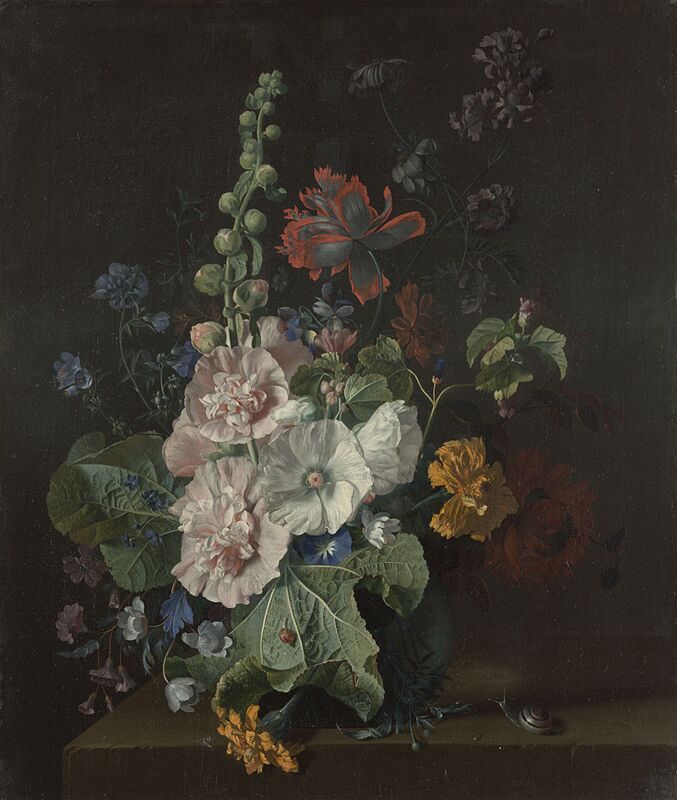
Jan van Huysum: ‘Hollyhocks and Other Flowers in a Vase’, 1702-20
A spectacular gathering of Dutch flower painting in Room 1 of the National Gallery raises several questions.
How have the relative economics of flowers and their depictions shifted? At the height of tulipmania – before the big price collapse in 1637 – a top bulb might cost the equivalent £20,000 in today’s money, so the painting would have been much cheaper than the items it showed. Now you’d struggle to pay more than £1 for a tulip bulb, whereas a good Pieter Claesz might fetch £1m at auction. I make that a modest 20,000,000,000-fold shift in the ratio.
What shall we do for a background? Monochrome spaces, visible interiors, architectural and garden settings are all in play…
How can you tell the various painters apart? If, sensibly enough, you take Jan Brughuel the Elder as a point of origin, then Bosshaart gives you flowers in a niche, Willem van Aelst introduces dramatic light, his pupil Rachel Ruysch instils a sense of movement; Jan van Huysum filters light right through the bouquet; and Davidz de Heem dynamises the blooms by varying their directions.
Which flowers are shown? Fear not, the display identifies them, often of course with seasonal incompatibilities in the same canvas.
What’s it all about? Death and transience, of course. But enjoyably so.

Rachel Ruysch: Flowers in a Glass Vase with a Tulip, 1716
The Art of Surprise: Paul’s ART STUFF ON A TRAIN #169
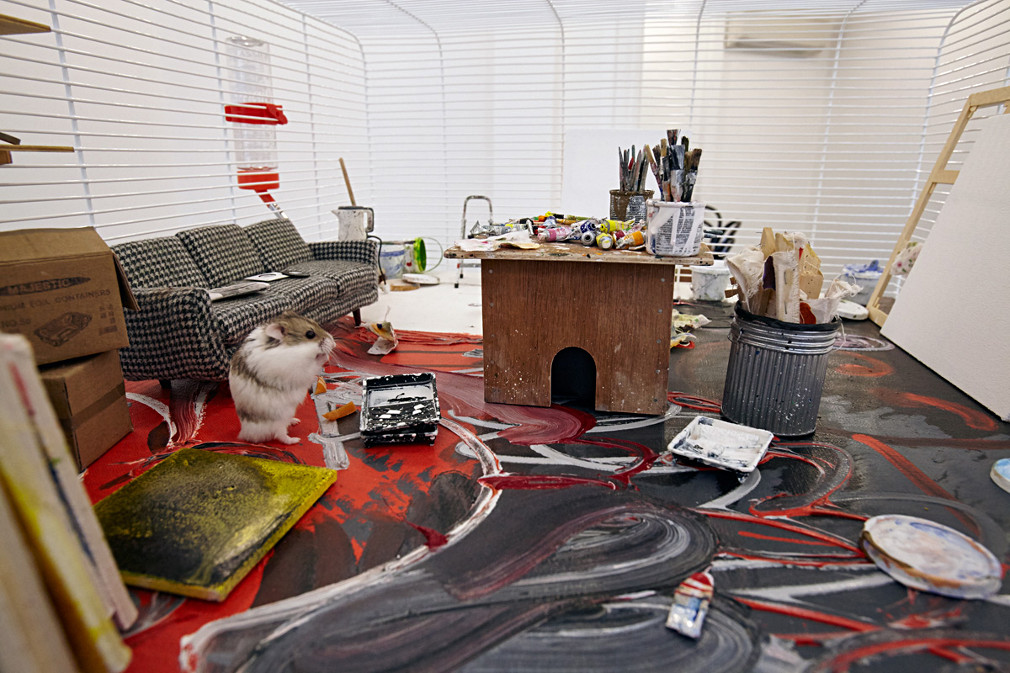
Luke Gottelier: ‘Hamster Studio’, 2016
Pretty much anything goes in contemporary art, but it’s still possible to be surprised, as I have been recently. Luke Gottelier (to 3 July) has form for performatively abusing paintings - using one as an ashtray, for example, and setting cats loose on another. http://brucehaines.com" target="_blank">At Bruce Haines’ Mayfair gallery
he's gone further by setting up a complete miniature studio in a hamster cage, ready for the hamster to move on to production. At http://www.copperfieldgallery.com" target="_blank">Copperfield Gallery (to 16th July) Spanish artist Marco Godoy has set up the referendum-topical opportunity to speak directly to one of several participating Syrian migrants currently living in Germany: they’ll tell you their story and answer questions if you ring from the gallery phone – which proved a discombobulating experience, at once intimate and distanced. Meanwhile at Art Basel, there were washing-up bowls full of dirty dishes on the floor of http://www.reenaspaulings.com" target="_blank">Reena Spallings’ space. The title ‘malewhitecorporateoppression’ indicated a feminist statement from an artist who – with plenty of experience living in communal arrangements - refuses to do the job left to women by men. In fact the work is not so casual: Georgie Nettell placed the ingredients to make the right stains for her purpose! If it had been, then Mike Bouchet deals with the other end of the process athttp://manifesta.org" target="_blank"> Manifesta in Zurich (to 18th Sept). In collaboration with the local sewage company, he’s made a hall-filling 80 tonne installation out of one day’s worth of Zurich’s human excrement. Though treated, it was still a little piquant…
Georgie Nettell: ‘White Male’, 2015
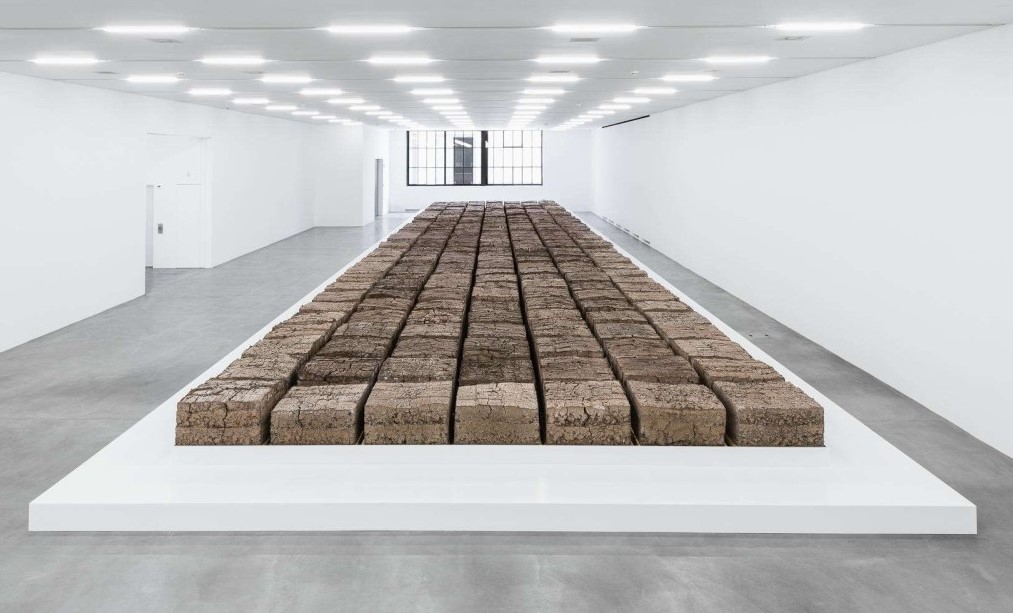
Mike Bouchet: ‘The Zurich Load’, 2016
Nifty after the Dream: Paul’s ART STUFF ON A TRAIN #168
John Hoyland: ‘15.3.76’, 1976
I like a nifty bit of curatorial alignment. Piano Nobile’s Aspects of Abstraction 1952-2007 (to 23 June) features particularly good William Scott, Tony Cragg and Sean Scully, two nice slices of William Pye and a fine canvas by the less-known Leo Davy – all covered in a proper catalogue with informative texts by Margaret Garlake and Julia Fischel. Its coup, however, is the proximity of Howard Hodgkin and John Hoyland. Hodgkin, of course, is an apparent abstractionist who calls himself a representational painter, albeit one who doesn’t paint appearances but ‘emotional situations’. The underlying subject is often his response to people*, and he’s showing at the National Portrait Gallery later this year. So it’s not too surprising that a sunscape can be read into ‘Transatlantic’, 2007, wittily presented on a bread board and suggestive of the setting of the American Dream. Hoyland, though, emerged from an interaction with American action painting at the acme of that dream, and is very much concerned with paint as subject and process to be made visible. You don’t expect a sunset in his earlier work, yet alongside Hodgkin I started to see one in ‘15.3.76’, a blockily translucent exploration of the weird pinks he handled particularly well.
* Perhaps it’s worth mentioning that Buphar Kakhar (Tate Modern to 6 Nov), a fellow-accountant and also the leading gay Indian painter, was a friend of Hodgkin’s whom he credits with a key role in coming to terms with his own sexuality.
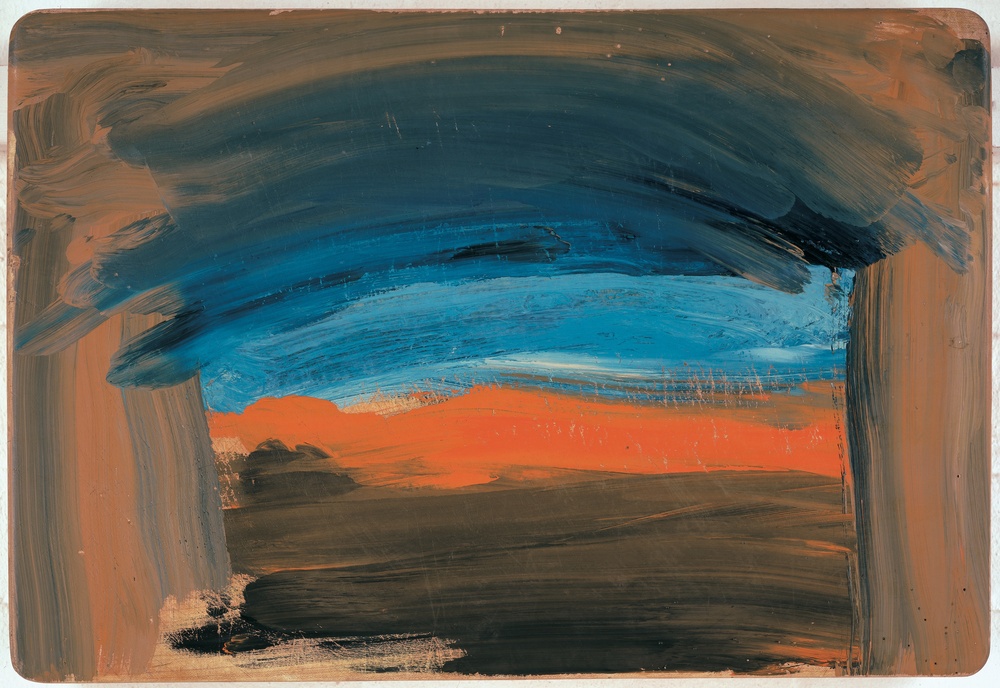
Howard Hodgkin: ‘Transatlantic’, 2007
Most days art Critic Paul Carey-Kent spends hours on the train, traveling between his home in Southampton and his day job in London. Could he, we asked, jot down whatever came into his head?
Will You Like Marmite? Paul’s ART STUFF ON A TRAIN #167
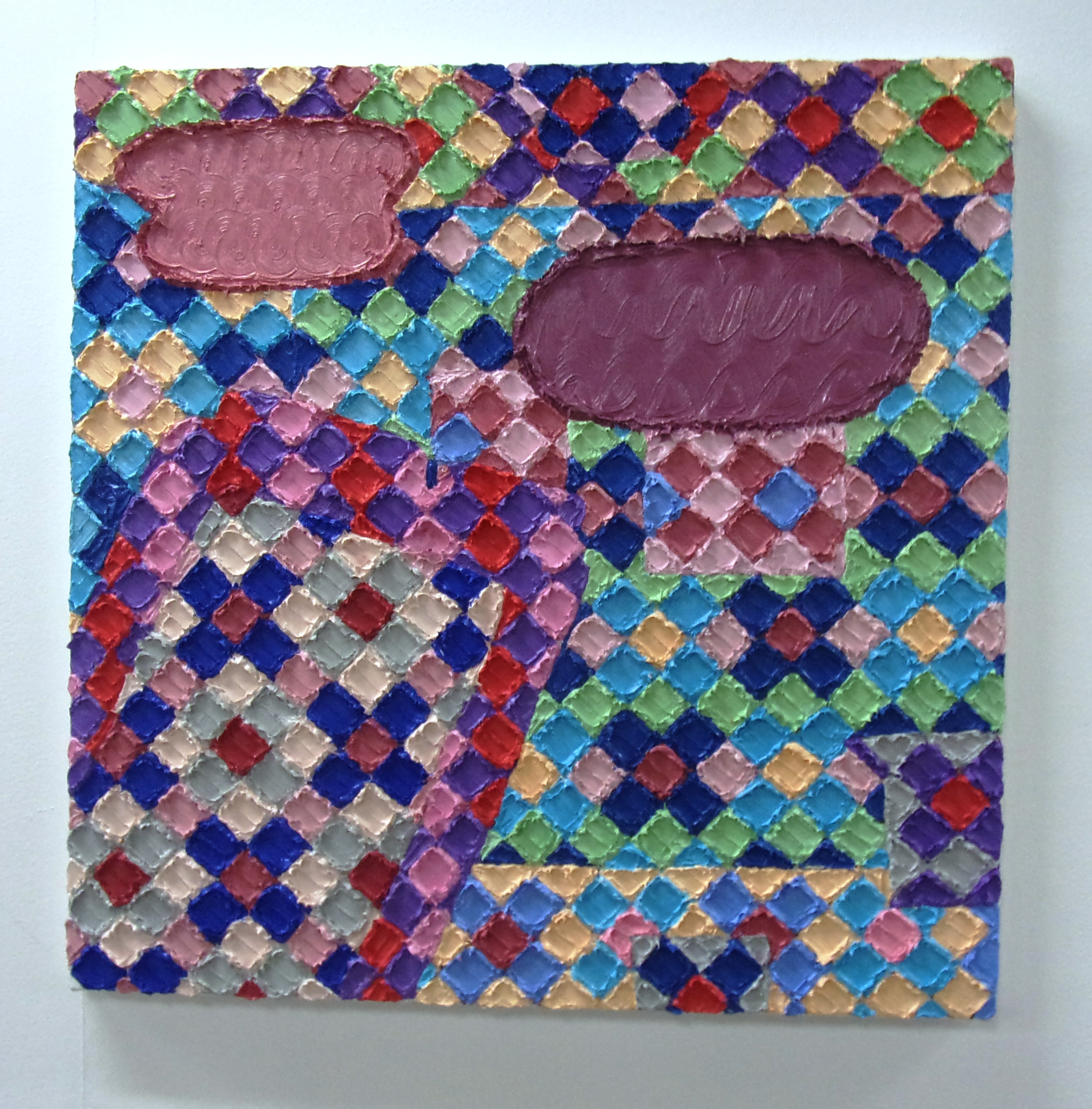
Suzy Willey: ‘Brink’, 2015
The Marmite Prize is perversely named: there’s no sponsorship
involved, and you’re meant to think of the earthenware stockpot from
which the yeasty spread took its name – but who does these days? It
comes around every two years or so and shares an absence of cash
inducement with the Jerwood Fellowships from last month. Given that most
of the prizes are literally ‘a pat on the back’ *, the Marmite is mainly
about honour, and this year, that’s considerable: in the inaugural year
2006 all 77 entries were exhibited, now 39 have been selected from 1,246
submissions to make up a most enjoyable mix at Block 336’s expansive
space in Brixton. Each edition is dedicated to an artist, and here it’s
Mary Heilmann (due soon at the Whitechapel), so organiser Marcus Cope
peppers the space cheerfully with his take on her chairs. Part of the
fun of such shows is, of course, to contradict the judges. For me,
there’s one outstanding figurative work – not the winner, but runner up
Emma Cousin’s ‘Square Shuffle’ – but overall the unplaced abstract works
have most punch: you could choose between Selma Parlour’s pellucidly
layered geometries; Steven Gee’s giant self-standing centrepiece with
mayonnaise; Lindsay Mapes’s multi-coloured Newman-baiting plethora of
zips; and – my joint winner – Suzy Willey. Her ‘Brink’ seems to pitch
cake decoration, speech bubbles and quilting into the marmite then stir
in such art influences as Jonathan Lasker and Jane Harris to piquant
effect.
* to be fair, the first prize (for Jessie Makinson, who has a well-timed solo show at Roman Road) is, in another tradition, a valuable sculpture (this year by Alison Wilding).

Emma Cousin: ‘Square Shuffle’, 2015-16 comes from a series of paintings featuring legs: here it is with one of the artist’s…
Most days art Critic Paul Carey-Kent spends hours on the train, traveling between his home in Southampton and his day job in London. Could he, we asked, jot down whatever came into his head?
Embassy Art Trips: Paul’s ART STUFF ON A TRAIN #166
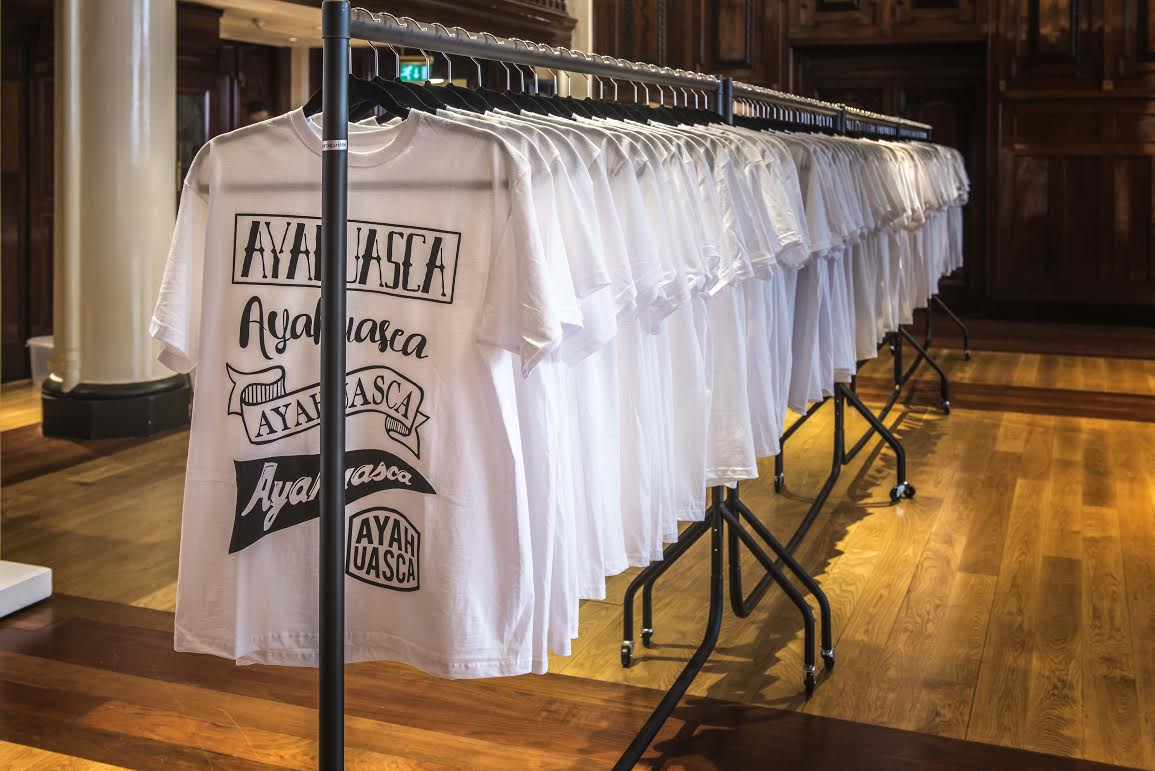
Adriano Costa, ‘Novos Contemporâneos, New Contemporaries, tea time’, 2015
London’s embassies can be good places for art. Germany and Sweden take an interest, and both Brazil and Canada have interesting shows freely accessible by the general public – and just a few yards apart at Trafalgar Square. The Brazilian Embassy actually has two large and characterful spaces. The first, known as Gallery 32 (USP: vertical neon tube lighting) recently showed British photographer Jason Oddy’s super-controlled explorations of Oscar Niemeyer’s modernist buildings in Algeria. The second, the grand Sala Brasil, is the former ticket hall for the Oceanic Steam Navigation Company. There HS Projects have installed four top Brazilian artists: Tonico Lemos Auad, Adriano Costa, Rodrigo Matheus and Matheus Rocha Pitta (to 2 July). ‘What separates us’ explores value systems and exchange mechanisms, complete with the chance to buy what has proved one of the most-commented-on garments I’ve ever worn. Costa’s range of T-shirt’s presents the hallucinogenic vine and leaf brew Ayahuasca, known for triggering vomiting and spiritual insight in shamanistic Amazonian ceremonies, as if it were a commercial brand. At Canada House, it’s well worth making your way through the airport-level security for ‘The Tremendous Elusive: Emily Carr and the Canadian Imaginary’ (to 19 June). That links paintings by the increasingly acclaimed Group of Seven member Emily Carr (1971-1945) to work by various Canadian successors.
Emily Carr: ‘Wood Interir’, 1932-5
Most days art Critic Paul Carey-Kent spends hours on the train, traveling between his home in Southampton and his day job in London. Could he, we asked, jot down whatever came into his head?
UNGLITTERING PRIZES: Paul’s Art Stuff on a Train # 165
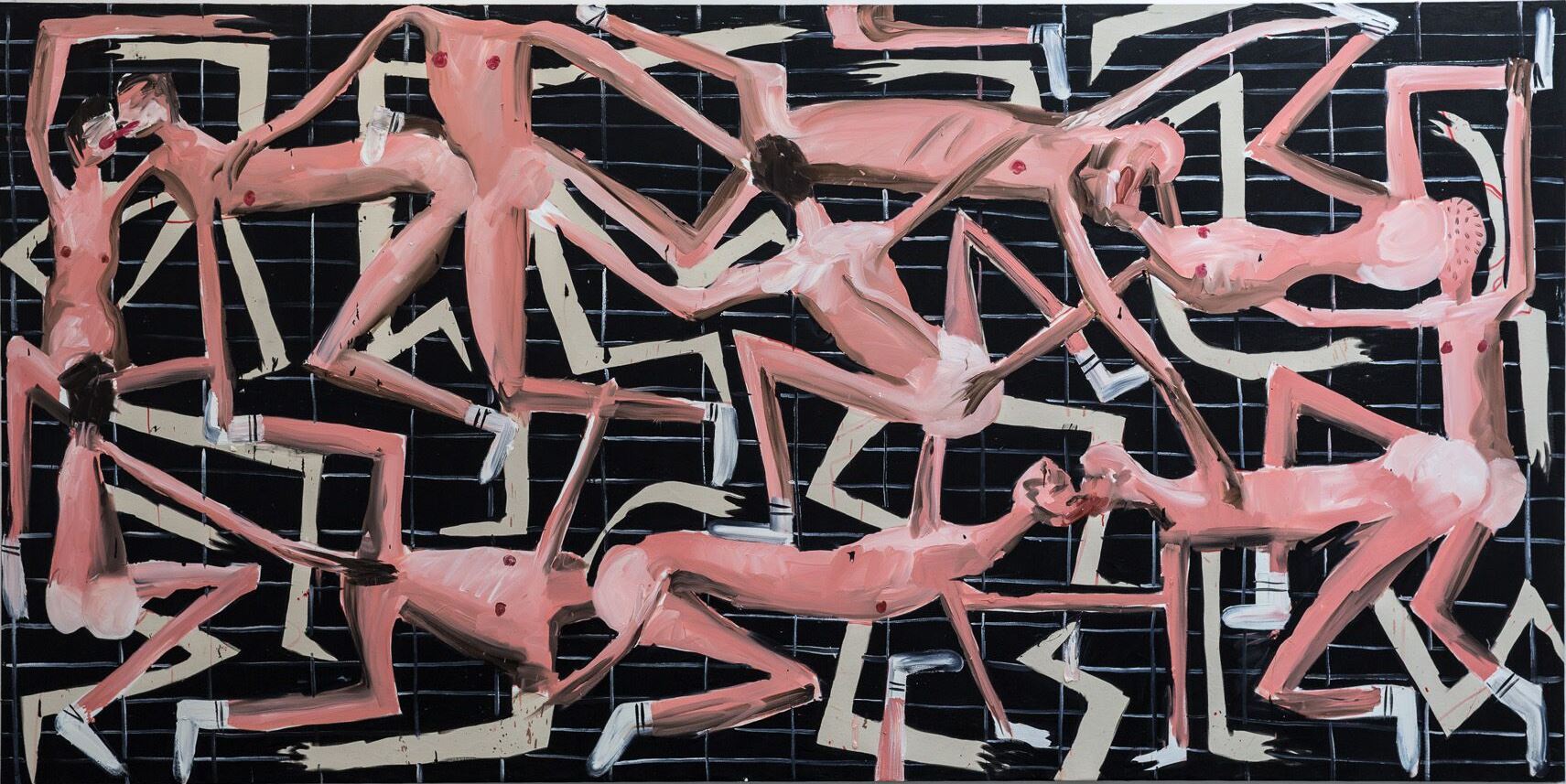
Dale Lewis: ‘Sunday Roast’, 2016 Photo © Dawn Smith
Money is a helpful and potentially empowering advantage for an artist. Yet by way of a prize, perhaps it’s even better to win the mentor-plus-show package awarded by the Jerwood Painting Fellowships. Three applicants from 400 were selected by Phoebe Unwin, Jane Harris and Dan Coombs, all prominent painter-teachers, and the year-round programme is just now concluding with a touring show of the resulting work (Jerwood Space, London to 19th June, then Bournemouth, Cardiff and Norwich). All three artists seem to have progressed to interesting positions. Dale Lewis (with Dan Coombs up), the only one whose work looks at all like his mentor’s, makes enormous multi-figure compositions, each in a frenzied sixteen hour session. He uses a widescreen format which bring a Pollock-like rhythm to daringly rapid paint-handling akin to Germans in the 1980s, and makes great use of patches of raw canvas. Lewis is already selling well, and his sex, drugs and alcohol triple has the biggest impact here. Francesca Blomfield (Phoebe Unwin) has what look like serial abstractions, but actually show hair and pasta with cunningly varied appearances of flatness and volume; and interior views of limousines, with vaguely transcendental colouring traded on by her own added texts ending in ‘day’. Archie Franks (Jane Harris) has the most varied practice, at its best in ‘Static’, which conflates a TV’s malfunction with a rain-driven seascape. All in all it makes for a lively show.
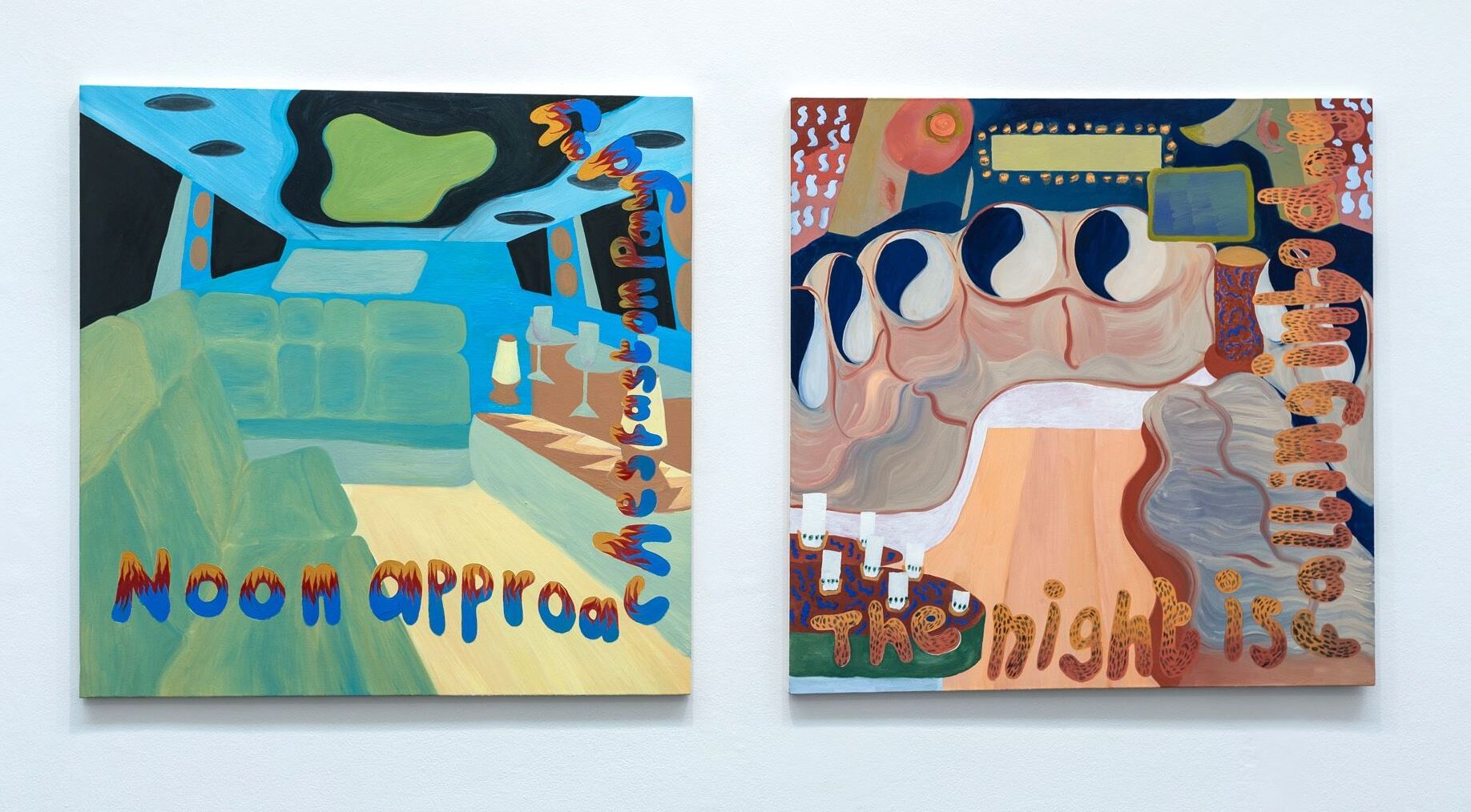
Francesca Blomfield – ‘Noon Approaches Fast on Payday’ and ‘The Night is Falling into Day’, 2016 Photo © Hydar Dewachi
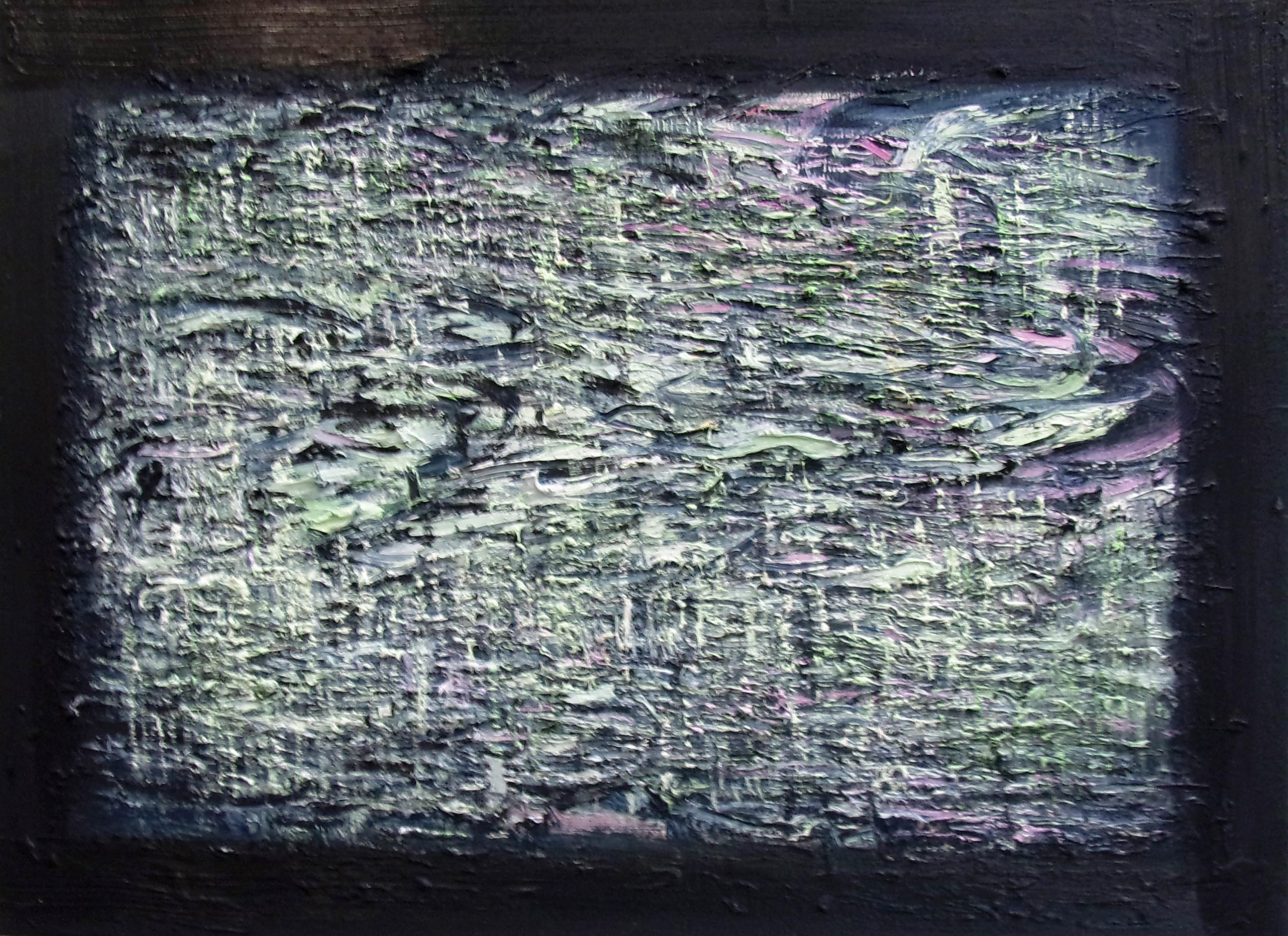
Archie Franks: ‘Static’, 2016 Photo © Hydar Dewachi
Memories of Conflict: Paul’s ART STUFF ON A TRAIN #164
Eugène Delacroix: ‘Weislingen Captured by Goetz’s Men’, 1853 – oil on canvas, 74 x 61 cm
Even by my standards, which I admit are a little crazy, I saw a lot of art in the week ending 5 May, visiting 80-odd galleries in Berlin, including most of the 54 which opened in sync for the admirable Berlin Art Weekend, plus 20 in London. So an interesting test is to ask: what comes instantly to mind, thinking back? Two works of conflict are first. The Delacroix show at the National Gallery has been roundly criticised for not including any of his large scale works and only a small proportion of Delacroix, whatever the size. I’m always more interested in what is in a show, and ‘Delacroix and the Rise of Modern Art’ (hurry – to 22 May) is chock-a-block with great paintings, including some outstanding, if small, examples by the man himself. ‘Weislingen Captured by Goetz’s Men’ creates a rotating three horse maelstrom of colour which confirms him as the finest ever painter of battle action: it looks like chaos, as it should, but there’s control in there too. Meanwhile in Berlin, Martin Honert creates an war memory at Berlin’s Johnen Gallery in one of three typically hallucinatory reconstructions of his childhood experiences through the sculptural imitation of photographic effects. ‘VSG-Gruppe’, 2015-16, is a 3D version of a 1956 black and white photograph of a sports club for the maimed, its grainy grey-glazed look enhanced by the incorporation of sand as it stands in for the ongoing social impact of World War II.
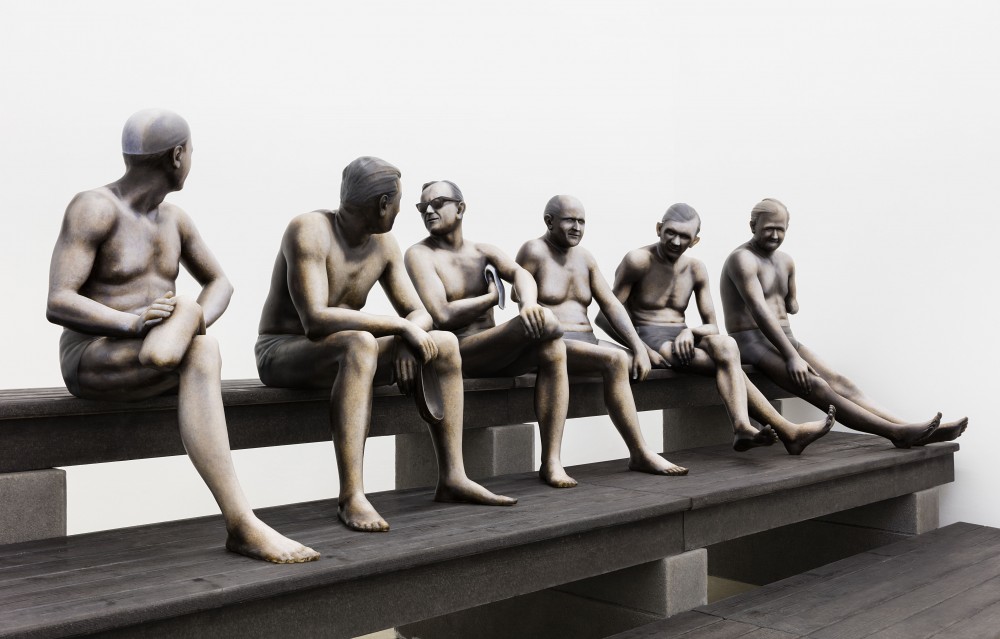
Martin Honert: ‘VSG-Gruppe’, 2015-2016, polyurethane, sand, wood, oil paint, 220 x 560 x 200 cm
Most days art Critic Paul Carey-Kent spends hours on the train, traveling between his home in Southampton and his day job in London. Could he, we asked, jot down whatever came into his head?
Not Quite All Night: Paul’s ART STUFF ON A TRAIN #163
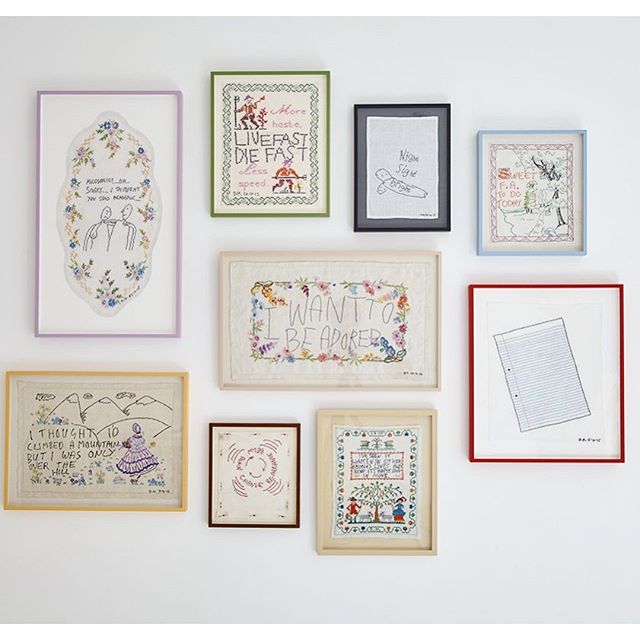
Des Hughes Installation view (photo Clare Woods)
For all the romantic bravado of pulling an inspired all-nighter, I suspect most artists have a more conventional routine alongside a more balanced view of their wider responsibilities than one associates with the denizens of the Cedar Tavern. That seems to be the case with Des Hughes, who shares a studio with his partner of 25 years, painter Clare Woods, and a home with their two children. The couple have a surprisingly comprehensive and most enjoyable double-display ‘The Sleepers’ in Chichester at the moment, which shows their work together and in relation to their choices from Pallant House’s collection. As you can see there (to 5 June), Hughes works by day on all manner of adventurous sculptural forms. Yet he also has a conveniently small-scale and unmessy ‘evening practice’, which fills the transitional half hour on return from the studio between art and domestic worlds. Hughes collects old cross-stitch ‘samplers’ which he updates through a mixture of unstitching, re-stitching, and occasional additions so that anachronistic words, often from rock lyrics, are smuggled in to counter the traditional context with wry gloom. ‘I thought I’d climbed a mountain’, for example, ‘but I was only over the hill’. Bruce Haines’ new Mayfair space, small as an art fair booth but well placed opposite Sotheby’s, is ideal for showing a dozen of these (‘XXX’, to 3 June). I like that idea of a time-specific practice, though I suspect few artists do much of their work at the favoured hour – 4.30 a.m. – at which I’m writing this…
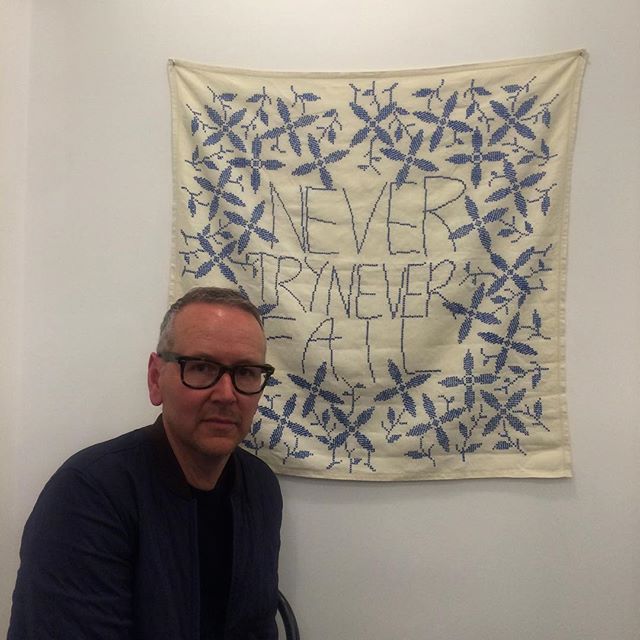
Hughes with ‘Never Try Never Fail’, 2015 (photo Simon Martin)
Fantasies of Prince Crumb: Paul’s ART STUFF ON A TRAIN #162
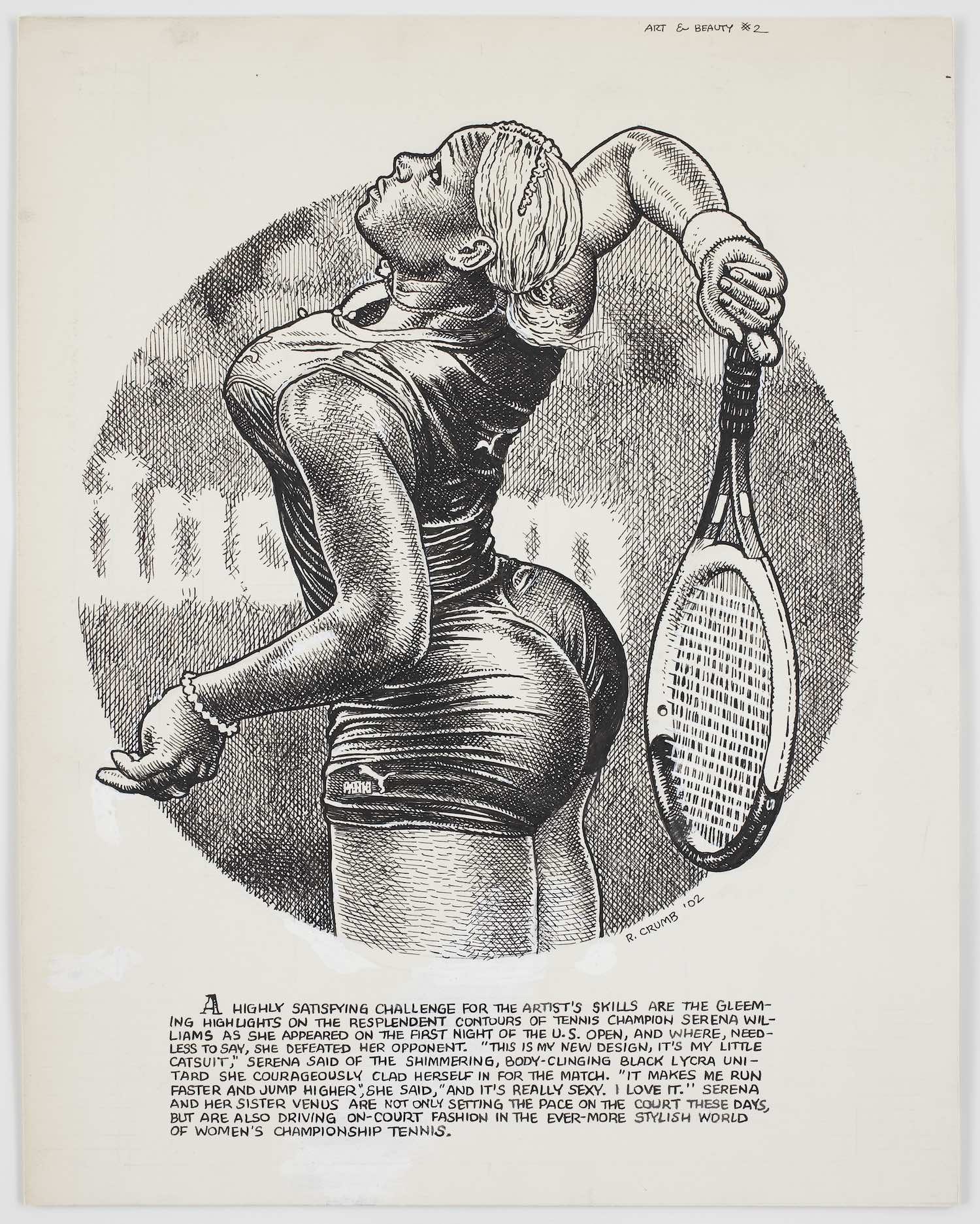
R.Crumb: from Art & Beauty 2, 2002
By way of curious confluence, two big names – Richard Prince and Robert Crumb – have impressively installed shows featuring depictions of women in which the artist might be seen to pursue his own fantasies. If there was nothing more to say, it wouldn’t be art, so what else is there? R. Crumb’s ‘Art & Beauty’ magazines, drawings from which are at David Zwirner to 2 June, see him transform various sources into his strapping type. As such, they play into the artistic tradition of the grotesque, paralleling for example Bruegel’s accounts of folk behaviour. Crumb also offsets the bawdy images with breathless pseudo-high-falutin’ texts which send up the artist’s own desires, academic commentaries on art, and how the media present women. The living artist known as Prince (Sadie Coles to 18 June) has a specially constructed corridor-come-shrine for a dozen big new paintings. Their grounds are blown-ups versions of 1960s cartoons in which buxom women are cast as playthings. Here, the subversion lies in how Prince references his most famous series – the joke paintings – and half-covers them with a hotchpotch anthology of his ‘own’ (largely borrowed) painting styles, in which Picasso and de Kooning loom large as classic depictors of the female nude – sort of a self-parody wrapped up in a wider parody. So is it enough? I suspect both artists are happy if the answer remains unclear, for such ambiguities and doubts can be what draw us into an engagement with, rather than a mere passive acceptance of, art. I’m not sure that’s enough either, but I am sure the not-rightness is the point.

Richard Prince: ‘Free Love #213’, 2015
Most days art Critic Paul Carey-Kent spends hours on the train, traveling between his home in Southampton and his day job in London. Could he, we asked, jot down whatever came into his head?
From Post-nationalism to Brexit: Paul’s ART STUFF ON A TRAIN #161
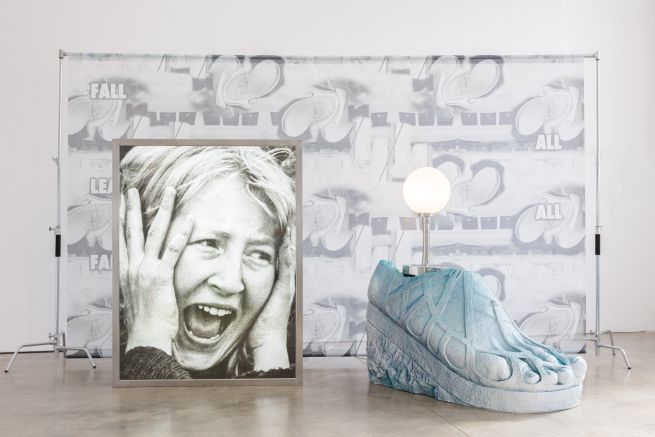
Guan Xiao: ‘Little Drum’, 2015 – incorporates a screaming Beatles fan
My first thought on seeing the ICA’s presentation of young Beijing-based artist Guan Xiao (‘Flattened Metal’ in collaboration with the K11 Art Foundation to 19 June) was that it looked pretty typical of the kind of show you’d see in Berlin. She derives her own cute logics from the contemporary overload of data, through both a video triptych of clips and sculptural collages in which items including muted speakers echo the colours of elaborately patterned backdrops which incorporate anthropological texts. It looks as if the Internet is a raw material too natural for her to make a point of using it, and with no bias at all towards China. Rather than criticise a lack of local flavour, I was inclined to see this as a post-nationalist and post-ideological. The same can be said of the combinations she shows against a striking photo-background of snakes at the Zabludowicz Collection (to 17th July). Her name looks pretty Chinese, though, and more memorable to the western ear than many, though it did occur to me that ‘Guen Xiao’ would be even better, so incorporating all five vowels with more economy than ‘European Union’. I wonder how flexible the transliteration of Chinese characters can be? That put me in mind – a rambling mind, it will be evident – of how the Brexit referendum debate hasn’t even asked the right question yet, let alone answered it. Like it or not, we’re currently part of Europe, so the right question is: ‘what would be best for Europe?’. When even the ‘stay’ camp are talking about what’s best for Britain, post-nationalist art feels like a timely move.
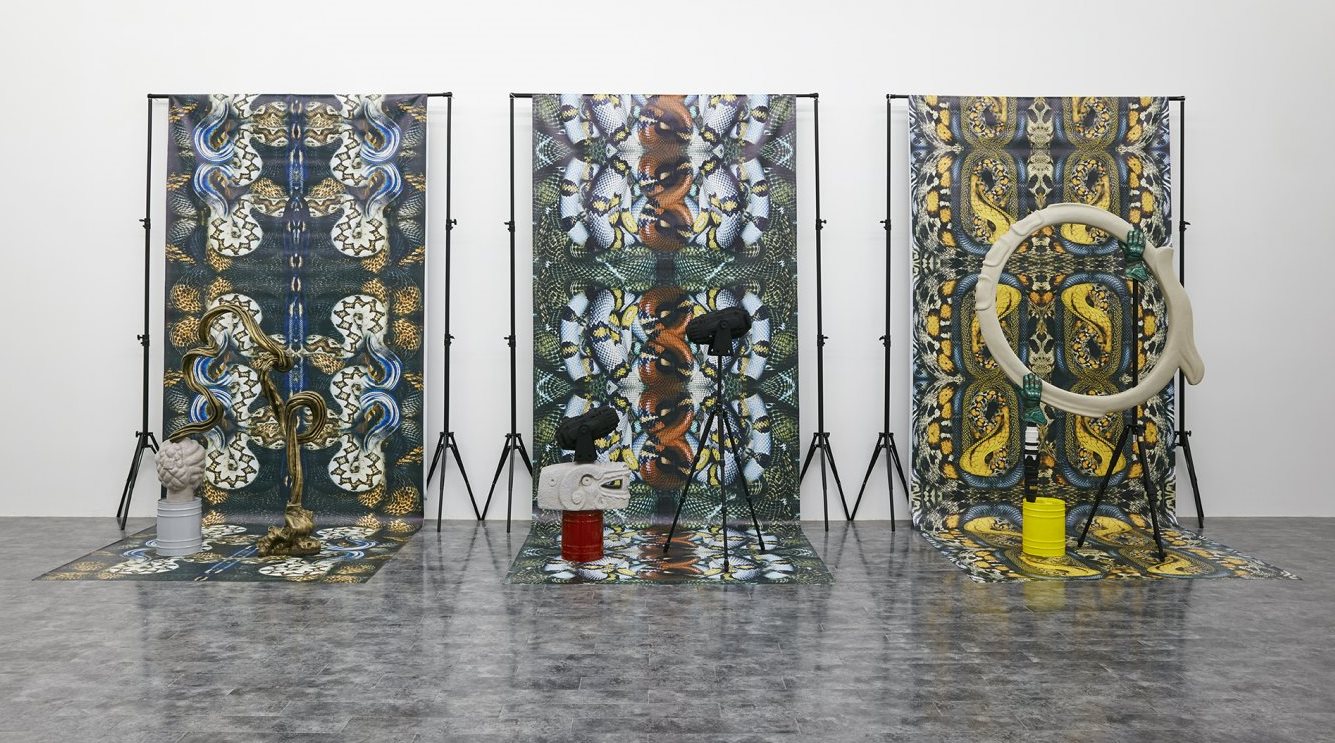
Guan Xiao: ‘Documentary: From National Geographic to BBC’, 2015. Photo: Zhang Hong

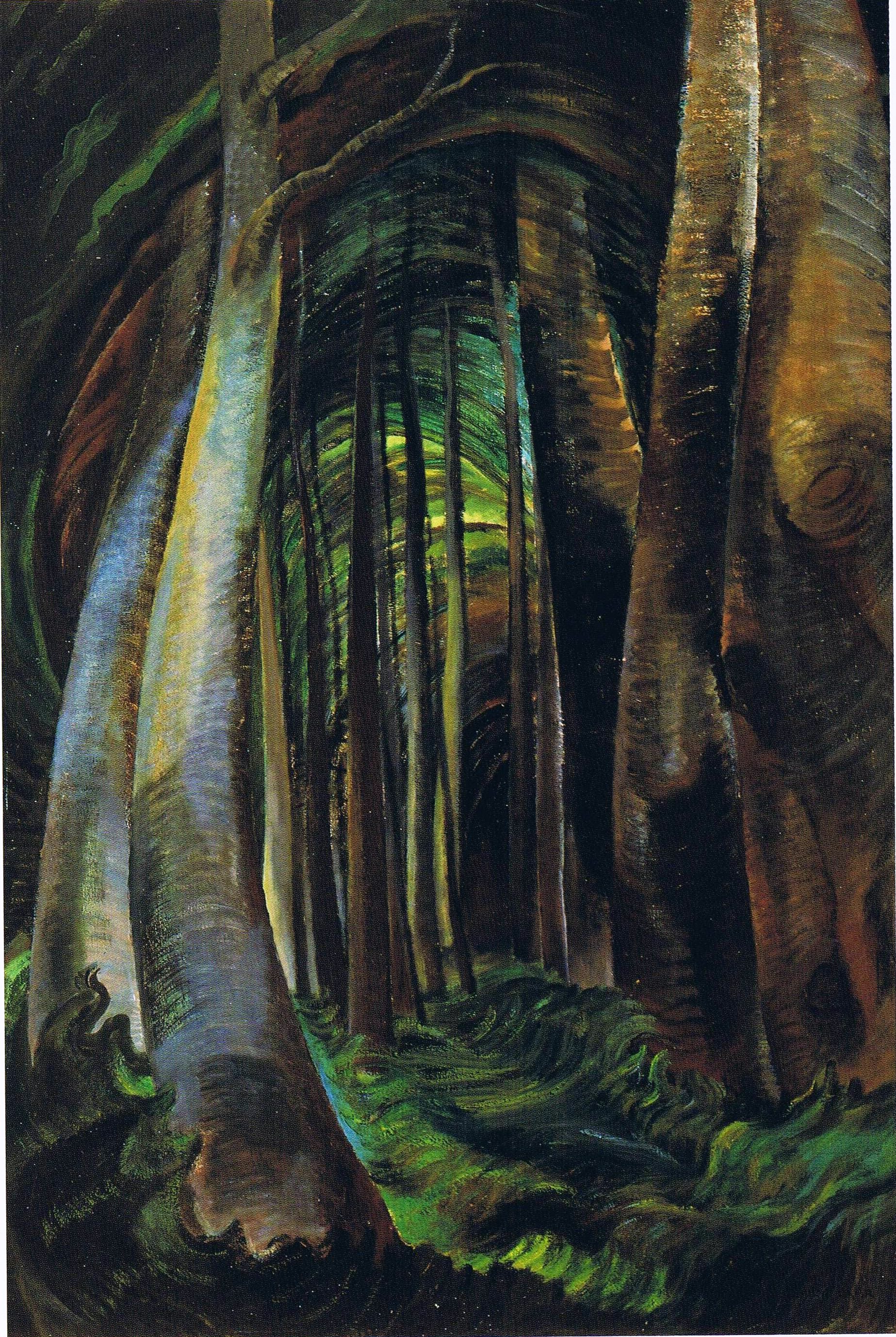
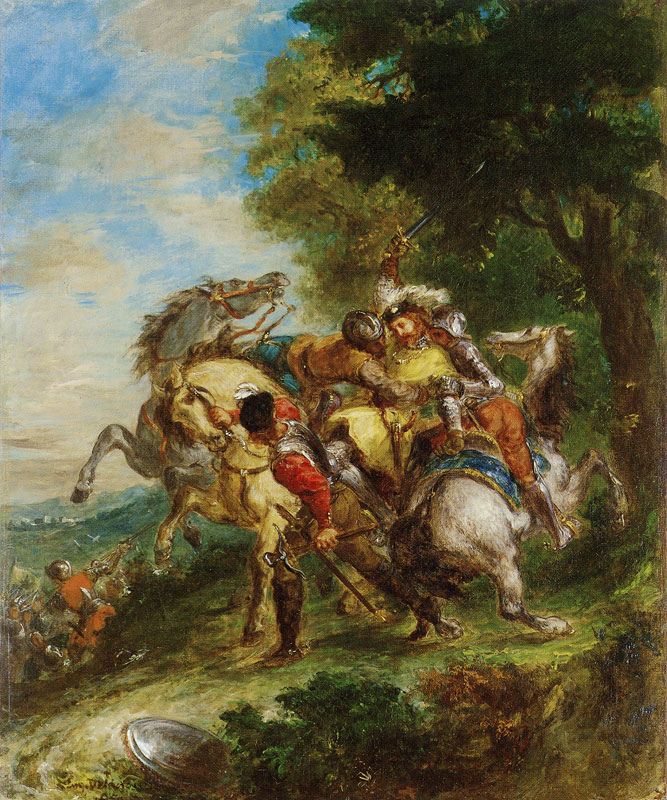

No comments:
Post a Comment
Note: only a member of this blog may post a comment.